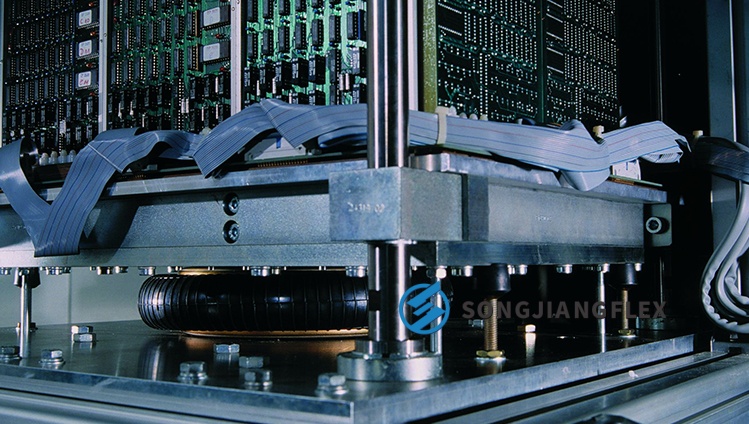Why Are Air Springs Essential for Modern Cloud Data Centers?
Vibrations and noise threaten cloud servers’ stability. Air Springs for Data Centers provide precise vibration isolation, protecting equipment and ensuring uninterrupted, efficient operation.
Air Springs for Data Centers reduce vibrations, protect servers and storage devices, enhance Data Center Cooling Efficiency, and extend IT equipment lifespan. Compared to traditional mounts, they improve reliability, support mission-critical operations, and maintain Data Center Uptime and Reliability.
Let’s explore how air springs safeguard cloud data centers and optimize performance across multiple critical areas.
1. How do air springs help reduce vibration in cloud data centers?
Cloud servers are extremely sensitive to even minor vibrations. Air Springs for Data Centers absorb mechanical shocks and environmental vibrations, keeping servers stable.
Air Springs provide superior Vibration Isolation for Servers, minimizing operational disruptions and protecting delicate hardware from micro-vibrations that can cause errors or reduce performance.
Data centers face constant vibrations from HVAC systems, nearby machinery, and building infrastructure. Air springs act as a buffer, dampening these vibrations before they reach sensitive servers. This ensures uninterrupted processing, reduces error rates in storage devices, and maintains consistent performance across high-density racks.
2. What role do air springs play in protecting servers and storage devices?
Servers and storage arrays require stable support to prevent hardware damage. Server Protection Air Suspension systems safeguard these critical components.
Air Springs protect hard drives, SSDs, and network storage devices by reducing shock and vibration, which can lead to data errors or premature hardware failure.
High-density data centers house thousands of drives. Even minor vibration can degrade read/write performance or cause mechanical failure. By using air springs, server racks remain balanced, reducing stress on disks and storage controllers, thereby prolonging equipment lifespan and protecting sensitive data.
3. Why are air springs better than traditional coil or rubber mounts in data centers?
Traditional coil or rubber mounts often fail to provide consistent isolation across varying loads. Air Springs vs Coil Mounts offer adjustable, long-lasting performance.
Air springs outperform conventional mounts by providing precise, adaptable isolation, maintaining stability under fluctuating server loads, and ensuring minimal vibration transfer.
Coil or rubber mounts may harden over time or react inconsistently under heavy equipment. Air springs’ pneumatic design allows tuning for specific loads, maintaining constant isolation efficiency. This makes them ideal for large-scale cloud facilities where reliability and low-maintenance operation are paramount.
4. How do air springs improve cooling efficiency in high-density server rooms?
Cooling efficiency depends on stable equipment alignment. Vibrations disrupt airflow and reduce heat dissipation effectiveness.
By stabilizing racks, Data Center Cooling Efficiency is enhanced, maintaining optimal airflow and reducing energy consumption in high-density environments.
Uneven server movement can block airflow channels, forcing fans to work harder and increasing power consumption. Air springs maintain precise rack positioning, enabling uniform airflow distribution and allowing cooling systems to operate at peak efficiency, which lowers energy costs and prevents hotspots in server rooms.
5. Can air springs extend the lifespan of IT equipment in cloud infrastructure?
Frequent vibrations accelerate wear on IT equipment. Extend IT Equipment Lifespan with air spring support.
Air Springs reduce mechanical stress on servers, storage devices, and network components, prolonging hardware life and reducing replacement frequency.
By minimizing constant micro-movements and shocks, air springs prevent premature degradation of components like hard drives, motherboards, and power supplies. This results in fewer hardware failures, lower maintenance costs, and improved return on investment for data center operators.
6. What are the cost-saving benefits of using air springs in large-scale data centers?
Operational costs are a key concern for cloud operators. Cost-Saving Vibration Isolation reduces maintenance and energy expenses.
Investing in air springs lowers repair costs, decreases downtime, and improves energy efficiency, making them a cost-effective solution for large-scale data centers.
Frequent equipment replacements, emergency repairs, and higher power consumption can inflate operational budgets. Air springs mitigate these costs by enhancing system stability, reducing wear, and optimizing cooling. Over time, the initial investment pays off through lower maintenance expenses and improved data center performance.
7. How do air springs contribute to uptime and reliability in mission-critical facilities?
Mission-critical facilities demand continuous operation. Air Springs support Data Center Uptime and Reliability with consistent vibration control.
Air Springs provide Mission-Critical Infrastructure Vibration Control, preventing unexpected shutdowns and maintaining high availability for essential applications.
Unexpected downtime can disrupt financial services, cloud platforms, and enterprise operations. Air springs reduce vibration-induced hardware failures, ensuring consistent uptime. Their reliability supports service-level agreements (SLAs) and enhances overall trust in cloud infrastructure performance.
8. Are air springs suitable for modular and edge data centers as well?
Smaller or modular data centers require flexible solutions. Air Springs for Modular Data Centers adapt to diverse setups.
Air springs’ lightweight, adjustable design fits modular and edge data centers, providing the same level of vibration isolation and equipment protection as traditional facilities.
Edge computing facilities often deploy in non-traditional spaces with structural limitations. Air springs’ compact design allows quick installation under server racks, cooling units, and UPS systems. This ensures vibration control without major structural modifications, maintaining performance even in decentralized or rapidly deployable data centers.
Summary
Air springs are vital for cloud data centers, providing vibration isolation, server protection, cooling efficiency, extended equipment lifespan, cost savings, and reliable uptime.






